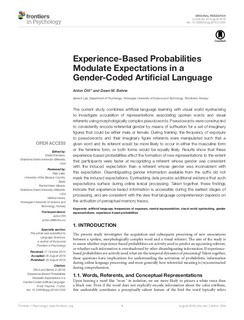| dc.contributor.author | Öttl, Anton | |
| dc.contributor.author | Behne, Dawn Marie | |
| dc.date.accessioned | 2016-09-07T14:16:19Z | |
| dc.date.accessioned | 2016-09-09T06:29:55Z | |
| dc.date.available | 2016-09-07T14:16:19Z | |
| dc.date.available | 2016-09-09T06:29:55Z | |
| dc.date.issued | 2016 | |
| dc.identifier.citation | Frontiers in Psychology 2016, 7 | nb_NO |
| dc.identifier.issn | 1664-1078 | |
| dc.identifier.uri | http://hdl.handle.net/11250/2405605 | |
| dc.description.abstract | The current study combines artificial language learning with visual world eyetracking to investigate acquisition of representations associating spoken words and visual referents using morphologically complex pseudowords. Pseudowords were constructed to consistently encode referential gender by means of suffixation for a set of imaginary figures that could be either male or female. During training, the frequency of exposure to pseudowords and their imaginary figure referents were manipulated such that a given word and its referent would be more likely to occur in either the masculine form or the feminine form, or both forms would be equally likely. Results show that these experience-based probabilities affect the formation of new representations to the extent that participants were faster at recognizing a referent whose gender was consistent with the induced expectation than a referent whose gender was inconsistent with this expectation. Disambiguating gender information available from the suffix did not mask the induced expectations. Eyetracking data provide additional evidence that such expectations surface during online lexical processing. Taken together, these findings indicate that experience-based information is accessible during the earliest stages of processing, and are consistent with the view that language comprehension depends on the activation of perceptual memory traces. | nb_NO |
| dc.language.iso | eng | nb_NO |
| dc.publisher | Frontiers Media | nb_NO |
| dc.rights | Navngivelse 3.0 Norge | * |
| dc.rights.uri | http://creativecommons.org/licenses/by/3.0/no/ | * |
| dc.title | Experience-Based Probabilities Modulate Expectations in a Gender-Coded Artificial Language | nb_NO |
| dc.type | Journal article | nb_NO |
| dc.type | Peer reviewed | nb_NO |
| dc.date.updated | 2016-09-07T14:16:19Z | |
| dc.source.volume | 7 | nb_NO |
| dc.source.journal | Frontiers in Psychology | nb_NO |
| dc.identifier.doi | 10.3389/fpsyg.2016.01250 | |
| dc.identifier.cristin | 1376707 | |
| dc.description.localcode | © 2016 Öttl and Behne. This is an open-access article distributed under the terms of the Creative Commons Attribution License (CC BY). The use, distribution or reproduction in other forums is permitted, provided the original author(s) or licensor are credited and that the original publication in this journal is cited, in accordance with accepted academic practice. No use, distribution or reproduction is permitted which does not comply with these terms. | nb_NO |

